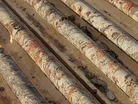Hudson and Neo agree deal for Sarfartoq exploration licence

Hudson Resources and Neo Performance Materials have announced the execution of a binding agreement which will see Neo acquire from Hudson an exploration licence covering the Sarfartoq Carbonatite Complex in southwest Greenland.
Supply chain solution for mineral deposits
In a statement, the companies explained that the project hosts a mineral deposit that is enriched in neodymium and praseodymium, two essential elements for rare earth permanent magnets used in electric vehicles, wind turbines, and high-efficiency electric motors and pumps that help reduce greenhouse gas emissions.
Located just 60kms from the international airport in Kangerlussuaq, the project is close to tidewater and a major port facility and is directly adjacent to some of the best hydroelectric potential in Greenland, it added.
Jim Cambon, Hudson’s President commented: “We are very pleased to have signed this agreement with a global leader in the production of advanced materials. As the world faces critical shortages of rare earth elements outside of China, we are pleased to help bring the Sarfartoq project a step closer to commercial reality.
“This deal provides a significant cash injection to the company and importantly, also gives Hudson shareholders potential significant upside in the future value of the Sarfartoq projects through equity or additional consideration.”
Through a special purpose entity (SPE), Neo intends to explore and develop the Sarfartoq Carbonite Complex to further diversify its global sourcing of rare earth ore and to expand the rare earth supply chains that feed its rare earth separation facility in Estonia.
The company is also planning to break ground on a greenfield rare earth permanent magnet manufacturing plant in Estonia that is intended to provide European manufacturers with the permanent magnets needed for electric and hybrid vehicles, wind turbines, and energy-saving electric motors and pumps.
The Sarfartoq Project also is a key element of Neo’s “Magnets-to-Mine” vertical integration strategy.
Completion of the sale of the licence is subject to various conditions, including approval from the Government of Greenland for the transfer of the Licence. This is expected to take approximately six months, while approval of the TSX Venture Exchange on the part of Hudson is also pending.
Neo added that it intends to assign its rights under the Agreement to an SPE controlled by itself that would hold the Licence and continue exploration and ultimately extraction of the rare earth elements.
The licence covers the large Sarfartoq carbonatite complex that hosts Hudson’s ST1 REE project and the Nukittooq Niobium-Tantalum project. The REEs on the Property have a high ratio of neodymium and praseodymium at 25%-40% of Total Rare Earth Oxides.
Hudson completed a Preliminary Economic Assessment on the ST1 project in November 2011 that outlined a National Instrument 43-101 compliant resource containing 27m kilograms of neodymium oxide and 8m kilograms of praseodymium oxide.
Three kilometres east of the ST1 Zone is another high-grade zone (ST40) that hosts one of the rare earth industry’s highest-known ratios of neodymium oxide to Total Rare Earth Oxide (TREO) — 45% — as shown by Hudson’s original mineralogical work (see NR2011-02).
Rare earth supply chain optionality
Neo and the SPE expect to conduct additional exploratory drilling and other work to move the Project forward to eventual commercial operation. Neo also intends to enter into an offtake agreement with the SPE with rights to purchase 60% of the ore or mineral concentrate produced from the Project.
Constantine Karayannopoulos, Neo’s President and Chief Executive Officer commented: “Neo continuously pursues supply chain optionality in order to ensure that our customers have a dependable supply of engineered rare earth products. Once in production, this project will significantly increase the diversity of global rare earth supply for our processing facilities around the world. It also is another step in our Magnets-to-Mine vertical integration strategy.
“Based on our significant experience in assessing strategic mineral resources around the world, we believe the Sarfartoq resource in Greenland is a strategic asset that uniquely complements Neo’s European rare earth magnet growth strategy.
“This resource would supplement our current supply of rare earth concentrate from Energy Fuels in the United States. We are very confident and supportive of the Greenlandic Government’s vision for sustainable-focused mining as the driver of their economic development, job creation, and growth. We are looking forward to working with Greenland to responsibly develop this resource into a producing mine, of which Neo would be the primary customer,” he concluded.



